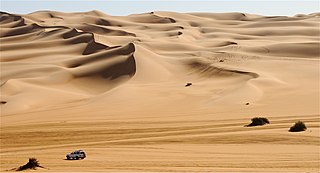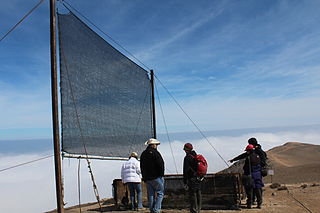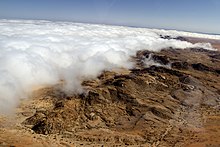
At 824,292 km2 (318,261 sq mi), Namibia is the world's thirty-fourth largest country. After Mongolia, Namibia is the second least densely populated country in the world. Namibia got its name from the Namib desert that stretches along the coast of the Atlantic. It is also known for its wildlife.

Dew is water in the form of droplets that appears on thin, exposed objects in the morning or evening due to condensation.

Fog is a visible aerosol consisting of tiny water droplets or ice crystals suspended in the air at or near the Earth's surface. Fog can be considered a type of low-lying cloud usually resembling stratus, and is heavily influenced by nearby bodies of water, topography, and wind conditions. In turn, fog affects many human activities, such as shipping, travel, and warfare.

The Namib is a coastal desert in Southern Africa. According to the broadest definition, the Namib stretches for more than 2,000 kilometres (1,200 mi) along the Atlantic coasts of Angola, Namibia, and South Africa, extending southward from the Carunjamba River in Angola, through Namibia and to the Olifants River in Western Cape, South Africa. The Namib's northernmost portion, which extends 450 kilometres (280 mi) from the Angola-Namibia border, is known as Moçâmedes Desert, while its southern portion approaches the neighboring Kalahari Desert. From the Atlantic coast eastward, the Namib gradually ascends in elevation, reaching up to 200 kilometres (120 mi) inland to the foot of the Great Escarpment. Annual precipitation ranges from 2 millimetres (0.079 in) in the aridest regions to 200 millimetres (7.9 in) at the escarpment, making the Namib the only true desert in southern Africa. Having endured arid or semi-arid conditions for roughly 55–80 million years, the Namib may be the oldest desert in the world and contains some of the world's driest regions, with only western South America's Atacama Desert to challenge it for age and aridity benchmarks.

A rain shadow is an area of significantly reduced rainfall behind a mountainous region, on the side facing away from prevailing winds, known as its leeward side.

Desert ecology is the study of interactions between both biotic and abiotic components of desert environments. A desert ecosystem is defined by interactions between organisms, the climate in which they live, and any other non-living influences on the habitat. Deserts are arid regions that are generally associated with warm temperatures; however, cold deserts also exist. Deserts can be found in every continent, with the largest deserts located in Antarctica, the Arctic, Northern Africa, and the Middle East.

Shrubland, scrubland, scrub, brush, or bush is a plant community characterized by vegetation dominated by shrubs, often also including grasses, herbs, and geophytes. Shrubland may either occur naturally or be the result of human activity. It may be the mature vegetation type in a particular region and remain stable over time, or a transitional community that occurs temporarily as the result of a disturbance, such as fire. A stable state may be maintained by regular natural disturbance such as fire or browsing. Shrubland may be unsuitable for human habitation because of the danger of fire. The term was coined in 1903.

Camanchacas are marine stratocumulus cloud banks that form on the Chilean coast, by the Earth's driest desert, the Atacama Desert, and move inland. In Peru, a similar fog is called garúa, and in Angola cacimbo. On the side of the mountains where these cloud banks form, the camanchaca is a dense fog that does not produce rain. The moisture that makes up the cloud measure between 1 and 40 microns across, too fine to form rain droplets.

Stenocara gracilipes is a species of beetle that is native to the Namib Desert in southern Africa. This is one of the most arid areas of the world, receiving only 1.4 centimetres (0.55 in) of rain per year. The beetle is able to survive by collecting water on its bumpy back surface from early morning fogs.

Climate of Peru describes the diverse climates of this large South American country with an area of 1,285,216 km2 (496,225 sq mi). Peru is located entirely in the tropics but features desert and mountain climates as well as tropical rainforests. Elevations above sea level in the country range from −37 to 6,778 m and precipitation ranges from less than 20 mm (0.79 in) annually to more than 8,000 mm (310 in). There are three main climatic regions: the Pacific Ocean coast is one of the driest deserts in the world but with some unique features; the high Andes mountains have a variety of microclimates depending on elevation and exposure and with temperatures and precipitation from temperate to polar and wet to dry; and the Amazon basin has tropical climates, mostly with abundant precipitation, along with sub-tropical climates in elevations above 1,550 m (5,090 ft).

The Norte Grande is one of the five natural regions into which CORFO divided continental Chile in 1950. It borders Peru to the north, the Pacific Ocean to the west, the Altiplano, Bolivia and Argentina to the east, and the Copiapó River to the south, beyond which lies the Norte Chico natural region.

Garúa is a Spanish word meaning drizzle or mist. Although used in other contexts in the Spanish-speaking world, garúa most importantly refers to the moist cold fog that blankets the coasts of Peru, southern Ecuador, and northern Chile, especially during the southern hemisphere winter. In Chile, a similar fog is called camanchaca. Garúa brings mild temperatures and high humidity to a tropical coastal desert. It also provides moisture from fog and mist to a nearly-rainless region and permits the existence of vegetated fog oases, called lomas.

The Atacama Desert is a desert plateau located on the Pacific coast of South America, in the north of Chile. Stretching over a 1,600 km (990 mi) strip of land west of the Andes Mountains, it covers an area of 105,000 km2 (41,000 sq mi), which increases to 128,000 km2 (49,000 sq mi) if the barren lower slopes of the Andes are included.

A desert is a barren area of landscape where little precipitation occurs and, consequently, living conditions are hostile for plant and animal life. The lack of vegetation exposes the unprotected surface of the ground to denudation. About one-third of the land surface of the Earth is arid or semi-arid. This includes much of the polar regions, where little precipitation occurs, and which are sometimes called polar deserts or "cold deserts". Deserts can be classified by the amount of precipitation that falls, by the temperature that prevails, by the causes of desertification or by their geographical location.

Fog collection is the harvesting of water from fog using large pieces of vertical mesh netting to induce the fog-droplets to flow down towards a trough below. The setup is known as a fog fence, fog collector or fog net. Through condensation, atmospheric water vapour from the air condenses on cold surfaces into droplets of liquid water known as dew. The phenomenon is most observable on thin, flat, exposed objects including plant leaves and blades of grass. As the exposed surface cools by radiating its heat to the sky, atmospheric moisture condenses at a rate greater than that of which it can evaporate, resulting in the formation of water droplets.
The Jama-Coaque Ecological Reserve is a 2,100-acre protected area of Pacific Equatorial Forest in coastal Ecuador. It is one of the last significant remnants of tropical moist forest and premontane cloud forest in the region between the Andes mountains and the Pacific Ocean in Ecuador. It is estimated that only 2% of the native forest still remains in coastal Ecuador. The Jama-Coaque Ecological Reserve is owned and managed by Third Millennium Alliance (TMA), a non-profit conservation foundation. It is part of the Tumbes-Chocó-Magdalena biodiversity hotspot as designated by Conservation International.

Lichens are a composite organism consisting of fungi and algae living in symbiotic relationship. They are well adapted to survive in harsh conditions. One of the many places they can be found is the Namib, the desert that gave Namibia its name. Fog in the coastal parts of the desert provides the necessary moisture for the organisms' survival. In the Namib they grow on shrubs, rocks and pebbles of the gravel plains. These small organisms can densely cover large areas, forming lichen fields.
Toktokkies are various species of beetles that belong to the large Tenebrionidae family, also known as Darkling beetle. Toktokkies do not belong to a particular tribe or genus of Tenebrionids, but rather a selection of flightless species that make distinct noises by tapping on the ground with the abdomen. The Tenebrionidae family to which these beetles belong is quite large, with almost 3,500 species inhabiting Southern Africa. Nearly 200 species of Toktokkies inhabit the Namibia and 20 have adapted to the extreme temperatures of the Namib Desert. The most common Toktokkies in the Namib Desert are the Fog Basking beetle and the button beetle or trench-digging beetle.

Lomas, also called fog oases and mist oases, are areas of fog-watered vegetation in the coastal desert of Peru and northern Chile. About 100 lomas near the Pacific Ocean are identified between 5°S and 30°S latitude, a north–south distance of about 2,800 kilometres (1,700 mi). Lomas range in size from a small vegetated area to more than 40,000 hectares and their flora includes many endemic species. Apart from river valleys and the lomas the coastal desert is almost without vegetation. Scholars have described individual lomas as "an island of vegetation in a virtual ocean of desert."



















